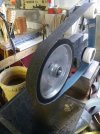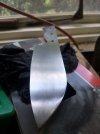- Joined
- May 21, 2012
- Messages
- 344
I have a couple of new surface conditioning belts that are course and ultra fine and I have a question about how to use them. I hand sanded to 120 grit then used the course belt then the ultra fine belt. The issue is that the blade looks incredible dull and even though I am using the belts vertically (from spine to edge) I am also getting horizontal scratches in my blade. What am I doing wrong? Do they need to be broken in or loaded with compound?
Thanks for the help.
Thanks for the help.




